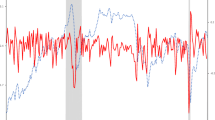Abstract
This paper utilizes calculated historical volatility and GARCH models to compare the historical price volatility behavior of crude oil, motor gasoline and heating oil in U.S. markets since 1990. We incorporate a shift variable in the GARCH/TARCH models to capture the response of price volatility to a change in OPEC’s pricing behavior. This study has three major conclusions. First, there was an increase in volatility as a result of a structural shift to higher crude oil prices after April 1999. Second, volatility shocks from current news are not important since GARCH effects dominate ARCH effects in the variance equation. Third, persistence of volatility in all commodity markets is quite transitory, with half-lives normally being a few weeks.





Similar content being viewed by others
Notes
In 1998, world crude oil production consistently exceeded demand, and inventories grew to unusually high levels. WTI spot prices fell to near $10 per barrel by the end of 1998 due to this excess of production and the resulting inventory build. In 1999, OPEC cut back production to a level well below demand, while the demand for crude oil increased as the Asian economies recovered. The excess inventories which had built up fell rapidly to below normal levels, and WTI spot prices rose rapidly to over $30 per barrel by the early March 2000.
Since the majority of our estimations, especially crude oil, showed statistically insignificant coefficients for the TARCH terms in the variance equation, we only utilized a TARCH model when the correlogram of squared residuals of the data did not indicate randomness.
Lagged values of moving average (MA) were added, if necessary, to the mean equation in order to correct for autocorrelation and to satisfy Q-statistics. This correction has virtually no effect on estimated parameters in the variance equation.
Since there are only 34 observations in period 2, Gulf-War I, this period is included in the stable market period. The estimation results without these observation did not change significantly.
Graphs for the futures markets are similar and available upon request.
Contrary to other commodities, RFG began listing on NYMEX in November 1994. Also, the sample size for the 6-month contract is shorter because of a three-week gap in trading while the older contract converted to RFG; the estimation results correspond to the RFG regime.
References
Bollerslev, T. (1986). Generalized autoregressive conditional heteroskedasticity. Journal of Econometrics, 31, 307–327.
Borenstein, S., Cameron, A. C., & Gilbert, R. (1997). Do gasoline prices respond asymmetrically to crude oil changes? The Quarterly Journal of Economics, 112, 305–339.
Engle, R. F. (1982). Autoregressive conditional and threshold adjustment. Journal of Business and Economic Statistics, 19, 166–176.
Glosten, L. R., Jagannathan, R., & Runkle, D. E. (1993). On the relation between expected value and the volatility of the nominal excess returns on stocks. Journal of Finance, 48, 1779–1801.
Hadsell, L., Marathe, A., & Shawky, H. A. (2004). Estimating the volatility of wholesale electricity spot prices in the US. The Energy Journal, 25, 23–40.
Hansen, P. R., & Lunde, A. (2001). A Comparison of Volatility Models: Does Anything Beat a GARCH (1, 1) Model? Brown University Working Paper.
Lee, K., Ni, S., & Ratti, R. A. (1995). Oil shocks and the macroeconomy: The role of price variability. Energy Journal, 16, 39–56.
Morana, C. (2002). IGARCH effects: An interpretation. Applied Economics, 9, 745–748.
Pindyck, R. S. (2004). Volatility in natural gas and oil markets. Journal of Energy and Development, Autumn, 1–19.
Poon, S.-H., & Granger, C. W. J. (2003). Forecasting volatility in finance markets: A review. Journal of Economic Literature, 41, 478–539.
Sadorsky, P. (1999). Oil price shocks and stock market activity. Energy Economics, 21, 449–469.
Zakoian, J. (1994). Threshold heteroskedastic models. Journal of Economic Dynamic and Control, 18, 931–995.
Author information
Authors and Affiliations
Corresponding author
Additional information
The views expressed are those of the authors and do not necessarily reflect those of the Energy Information Administration. The authors would like to thank Yavuz Koruk for his research assistance.
Rights and permissions
About this article
Cite this article
Lee, T.K., Zyren, J. Volatility Relationship between Crude Oil and Petroleum Products. Atl Econ J 35, 97–112 (2007). https://doi.org/10.1007/s11293-006-9051-9
Published:
Issue Date:
DOI: https://doi.org/10.1007/s11293-006-9051-9




